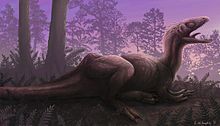- Concavenator
-
Concavenator
Temporal range: Early Cretaceous, 130 Ma
Type specimen Scientific classification 
Kingdom: Animalia Phylum: Chordata Class: Reptilia Superorder: Dinosauria Order: Saurischia Suborder: Theropoda Family: †Carcharodontosauridae Genus: †Concavenator
Ortega, Escaso & Sanz, 2010Species: †C. corcovatus Binomial name Concavenator corcovatus
Ortega, Escaso & Sanz, 2010Concavenator is a genus of theropod dinosaur that lived approximately 130 million years ago during the early Cretaceous period (Barremian stage). The type species is C. corcovatus; Concavenator corcovatus means "hump backed hunter from Cuenca".[1] The fossil was discovered in the Las Hoyas fossil site of Spain by paleontologists José Luis Sanz, Francisco Ortega and Fernando Escaso from the Autonomous University of Madrid[2] and the National University of Distance Learning.[1]
Contents
Description
Concavenator was a medium-sized (roughly 6 meters (20 feet) long) primitive carcharodontosaurian dinosaur possessing several unique features. Two extremely tall vertebrae in front of the hips formed a tall but narrow and pointed crest (possibly supporting a hump) on the dinosaur's back.[3] The function of such crests is currently unknown. Paleontologist Roger Benson from Cambridge University speculated that one possibility is that "it is analogous to head-crests used in visual displays", but the Spanish scientists who discovered it noted it could also be a thermal regulator.[1]
Additionally, the forelimb (ulna) of Concavenator preserved evidence of what may be quill knobs or homologous structures, an anatomical feature so far known only in animals with large, quilled feathers on the forelimb.[3]
Feathers and scales
Concavenator had structures resembling quill knobs on its forearm, a feature known only in birds and other feathered theropods, such as Velociraptor. Quill knobs are created by ligaments which attach to the feather follicle, and since scales do not form from follicles, the authors ruled out the possibility that they could indicate the presence of long display scales on the arm. Instead, the knobs probably anchored simple, hollow, quill-like structures. Such structures are known both in coelurosaurs such as Dilong and in some ornithischians like Tianyulong and Psittacosaurus. If the ornithischian quills are homologous with bird feathers, their presence in an allosauroid like Concavenator would be expected.[3] However, if ornithischian quills are not related to feathers, the presence of these structures in Concavenator would show that feathers had begun to appear in earlier, more primitive forms than coelurosaurs. Feathers or related structures would then likely be present in the first members of the clade Neotetanurae, which lived in the Middle Jurassic. No impressions of any kind of integument were found near the arm, although extensive scale impressions were preserved on other portions of the body, including broad, rectangular scales on the underside of the tail, bird-like scutes on the feet, and plantar pads on the undersides of the feet.[3]
Some amount of skepticism exists among experts about the validity of the interpretation that the ulna bumps represent quill knobs, though a more detailed analysis has not yet been published. Darren Naish of Tetrapod Zoology speculates that the bumps would have been unusually far up and irregularly spaced for quill knobs. He additionally pointed out that many animals have similar structures along intermuscular lines that act as tendon attachment points among other things.[4]
See also
References
- ^ a b c Laursen, L. (2010). "Crested dinosaur pushes back dawn of feathers." Nature News, 8-Sept-2010. Accessed online 9-Sept-2010.
- ^ Rivera, A. (2010). "Descubierto en Cuenca un dinosaurio carnívoro de una especie desconocida hasta ahora." El Pais.com, 8-Sept-2010. Accessed online 9-Sept-2010.
- ^ a b c d Ortega F., Escaso, F. and Sanz, J.L. (2010). "A bizarre, humped Carcharodontosauria (Theropoda) from the Lower Cretaceous of Spain." Nature, 467: 203-206. doi:10.1038/nature09181 PMID 20829793
- ^ Naish, D. (2010). Concavenator: an incredible allosauroid with a weird sail (or hump)... and proto-feathers?. Tetrapod Zoology, September 9, 2010.
External links
Categories:- Carnosaurs
- Cretaceous dinosaurs
- Dinosaurs of Europe
- Feathered dinosaurs
- Fossil taxa described in 2010
Wikimedia Foundation. 2010.





